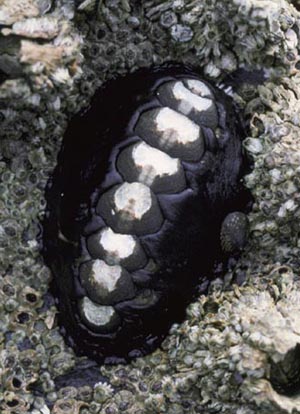Investigation 1 - The Legend of the Bidarki
| Class Time Required | 3 class periods |
| Materials Needed |
|
| Teacher Preparation | 45 minutes to read, make copies, and obtain food samples |
| Prior Student Knowledge | Knowledge of habitat and food webs, and understanding of interconnections in ecological systems. See 4th grade “Mystery of the Sea Otter Unit.” |
| Vocabulary | Bidarki, Biodiversity, Endangered Species, Extinction, Harvest, Invertebrate, Leather Chiton/Katy Chiton, Mollusk, Predation, Radula, Subsistence |
| Science GLEs Addressed |
3rd grade: SA3.1, SE1.1, SE2.1 4th grade: SA3.1, SE1.1, SE2.1, SE2.2 5h grade: SA3.1, SE1.1, SE2.1, SE2.2 |
| Other GLEs Addressed |
![]() Overview: Students develop an understanding of interconnections among the ocean, humans, and other living things through a case study of harvesting bidarki (katy chitons) in the Alaska Native villages of Port Graham and Nanwalek. They reflect on their own connections to the ocean.
Overview: Students develop an understanding of interconnections among the ocean, humans, and other living things through a case study of harvesting bidarki (katy chitons) in the Alaska Native villages of Port Graham and Nanwalek. They reflect on their own connections to the ocean.
Focus Question:
How are people who harvest marine life such as bidarkis part of an interconnected system?
Engagement: (15 minutes)
Bring in some samples of a food (berries, fish, edible plants, etc) that are found in your area and have students try them. Briefly discuss food sources for Alaskans now, and how they differ from food sources 100 years ago.
Tell students that they are going to read a story about human use of a resource from the ocean and how the people and the ocean ecosystem are interconnected.
Show students an example of a bidarki (katy chiton), and locate the villages of Port Graham and Nanwalek on a map.
Exploration: (30 minutes)
Distribute the introduction to the “Legend of the Bidarki ” story, and read it together as a class, then divide students into four groups. Ask groups 1 and 2 to be “residents of Port Graham and Nanwalek” and give them Part 2a and Part 2b to read. Groups 3 and 4 will be “university scientists” and read Parts 3a and 3b . Let students know that they will report to the class the section that they read, and assign parts. Give the students time to read.
Ask Group 1 to explain to the class what they read in part 2a of the story. They could take turns, with one student asking each of the questions that the villagers had about the bidarki. Discuss that part of the story and ask if students have any additional questions to ask.
Ask Group 2 to report on part 3a of the story, telling the rest of the class why scientists wanted to study the bidarki. Discuss methods that scientists might use to try to answer some their questions.
Group 3 will report on part 2b of the story. Ask students to take turns reporting each of the statements that the elders told the scientists.
Finally, ask Group 4 to report on what scientist Ann Salomon found as a result of her study, part 3b.
Distribute the conclusions of the story and read them together as a class.

Explanation: (30-40 minutes)
Discuss the interconnections in the story using a graphic organizer: On the board or overhead projector, ask students to help fill in “bubbles” to represent the various parts of the ecosystem near Port Graham and Nanwalak, including:
- People who live in the villages
- Bidarki (Katy Chiton, Black Leather Chiton)
- Sea Otter
- Sea Star
- Cod or Halibut (substitute subsistence harvest in times when bidarki were scarce)
As a class, draw arrows between the bubbles to indicate the type of interactions that took place in the story.
Each student could replicate (and/or add to) the graphic organizer in their science notebook as the discussion takes place.
Talk about the problem that people in the villages face and possible solutions to that problem.
Ask students to reflect in their science notebooks on these questions:
- How did modern technology affect the way that the people in Nanwalek and Port Graham used the ocean?
- Whose responsibility is it to take care of the ocean and its resources?
- How do scientists help solve problems of conserving the ocean’s resources?
Elaboration (20-25 minutes)
Human-Ocean Interactions. Distribute the Concept Web graphic organizer and ask students to fill it in with their personal and community connections to the ocean. They should put their own names at the center of the web, and also include connections between other parts of the web. (i.e., they are connected to their uncle, the fisherman; and to their aunt, the marine biologist, and those two are connected to each other. Or, they eat salmon and they have an uncle and the uncle fishes for salmon and they love to watch eagles and eagles eat salmon.)
Help students focus on finding significant connections, rather than simply listing as many as they can.
In their science notebooks, have students explain:
- How and why the ocean is important to me, OR
- How would my life change if I had no connections to the ocean?
Evaluation:
Assess student understanding as demonstrated by their:
- Completed Connections Web
- Science notebook responses, observations, and hypotheses
Teacher Preparation:
|
Tips from Teachers |
|
No tips are currently available. |
-
Read through the lesson and the background material
-
Make overhead transparencies as needed
-
Make copies of the student materials
-
Obtain some samples of a local food
Curricular Connections:
Art. Have students build a salt dough model of the bidarki and label it.
Writing. Nonfiction writing will be addressed through the continued use of the student science notebook.
Ideas for adapting to different local environment or context:
Lesson Extensions: Students can create an “Ocean Events” collage using clippings from recent newspapers, magazines, or the Internet, that have to do with local or global issues pertaining to ocean/human interactions.
| Student Handouts |
Concept Web Worksheet Science notebooks |
| Items for Group Display |
Map Concept Web Worksheet, if desired |
| Material Items |
Samples of local foods Bidarki picture or actual bidarki Chart paper and markers for creating concept map Pencils Glue and scissors for gluing worksheets into science notebooks |
| Facility/Equipment Requirements |
Overhead projector, or LCD projector |
Alaska Science Grade Level Expectations Addressed:
3rd Grade GLEs addressed:The student demonstrates an understanding that interactions with the environment provide an opportunity for understanding scientific concepts by:
[3] SA3.1 observing local conditions that determine which plants and/or animals survive (L)
The student demonstrates an understanding of how to integrate scientific knowledge and technology to address problems by:
[3] SE1.1 identifying local problems and discussing solutions (L)
The student demonstrates an understanding that solving problems involves different ways of thinking, perspectives, and curiosity by:
[3] SE2.1 identifying local tools and materials used in everyday life (L)
4th Grade GLEs addressed:
The student demonstrates an understanding that interactions with the environment provide an opportunity for understanding scientific concepts by:
[4] SA3.1 identifying the local limiting factors (e.g., weather, human influence, species interactions) that determine which plants and/or animals survive (L
The student demonstrates an understanding of how to integrate scientific knowledge and technology to address problems by:
[4] SE1.1 recognizing that tools (e.g., spear, hammer, hand lens, kayak, computer) and processes (e.g., drying fish, sewing, photography) are an important part of human cultures
The student demonstrates an understanding that solving problems involves different ways of thinking, perspectives, and curiosity by:
[4] SE2.1 identifying the function of a variety of tools (e.g., spear, hammer, hand lens, kayak, computer)
[4] SE2.2 identifying multiple explanations (e.g., oral traditions, folklore, scientific theory) of everyday events (e.g., weather, seasonal changes) (L)
5th Grade GLEs addressed:
The student demonstrates an understanding that interactions with the environment provide an opportunity for understanding scientific concepts by:
[5] SA3.1 identifying the limiting factors (e.g., weather, human influence, species interactions) that determine which plants and/or animals survive.
The student demonstrates an understanding of how to integrate scientific knowledge and technology to address problems by:
[5] SE1.1 identifying a community problem or issue and describing the information needed to develop a scientific solution. (L)
The student demonstrates an understanding that solving problems involves different ways of thinking, perspectives, and curiosity by:
[5] SE2.1 investigating a problem or project over a specified period of time and identifying the tools and processes used in that project. (L)
[5] SE2.2 comparing multiple explanations (e.g., oral traditions, folklore, scientific theory) of everyday events (e.g., weather, seasonal changes). (L)
Essential Questions:
Enduring Understandings:
|





